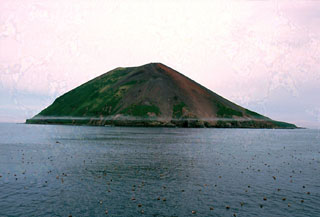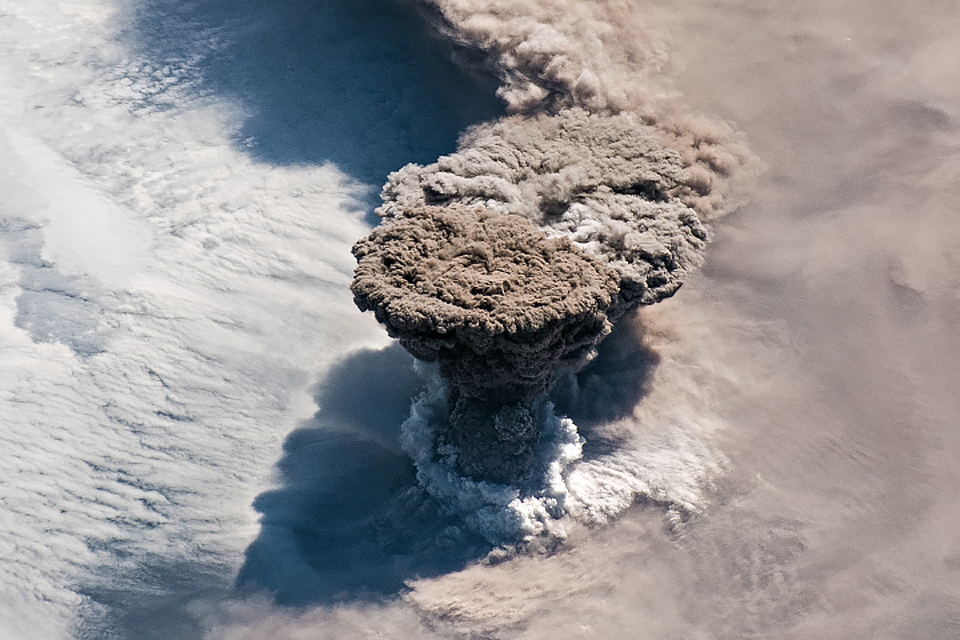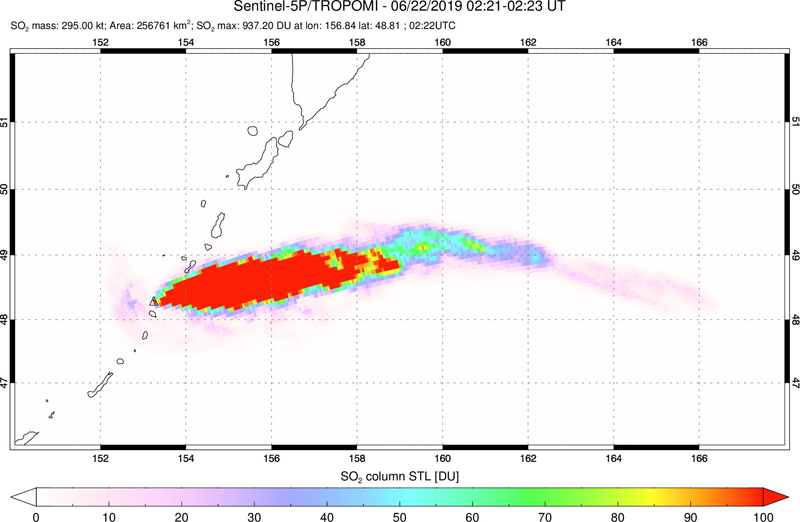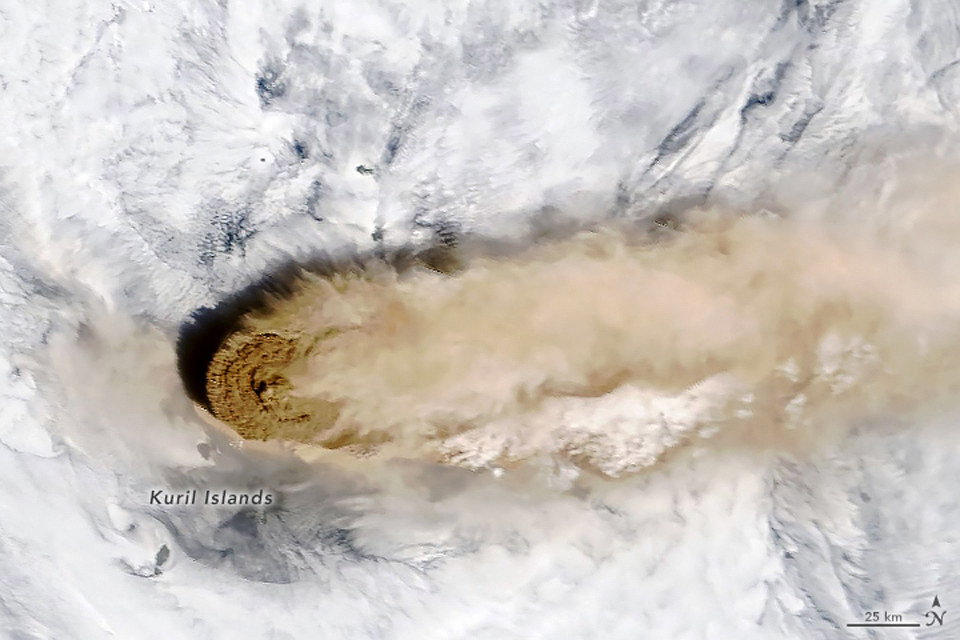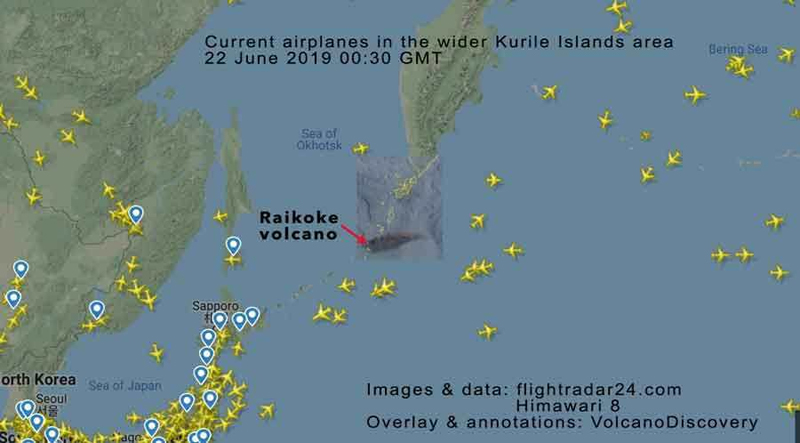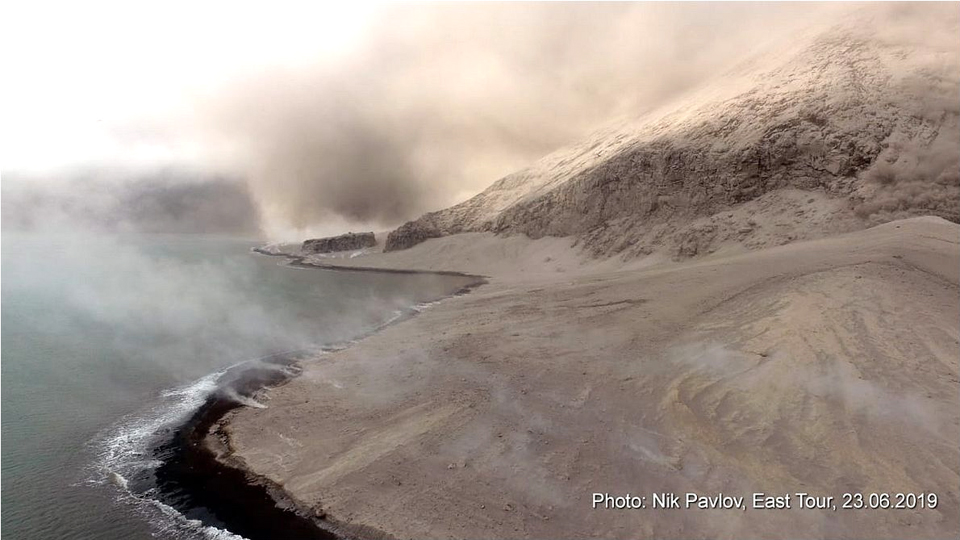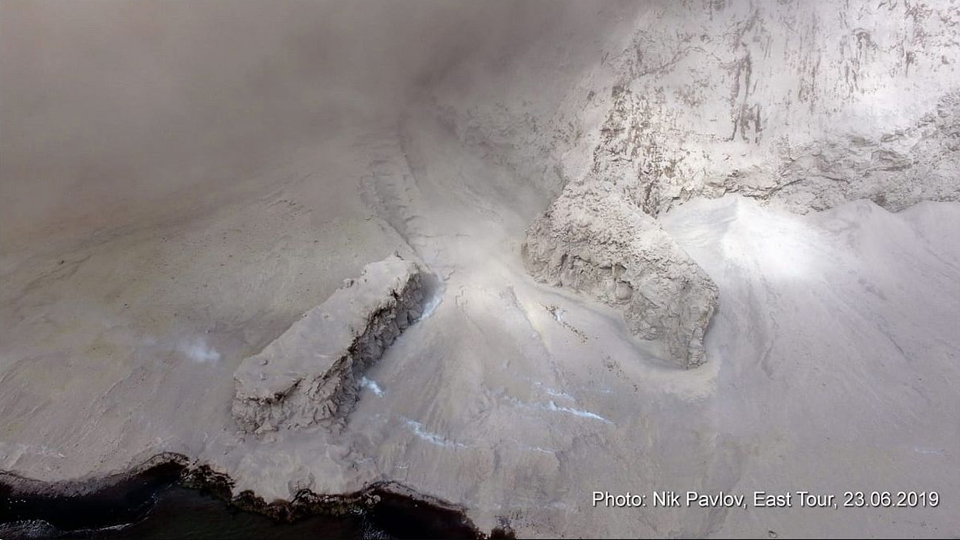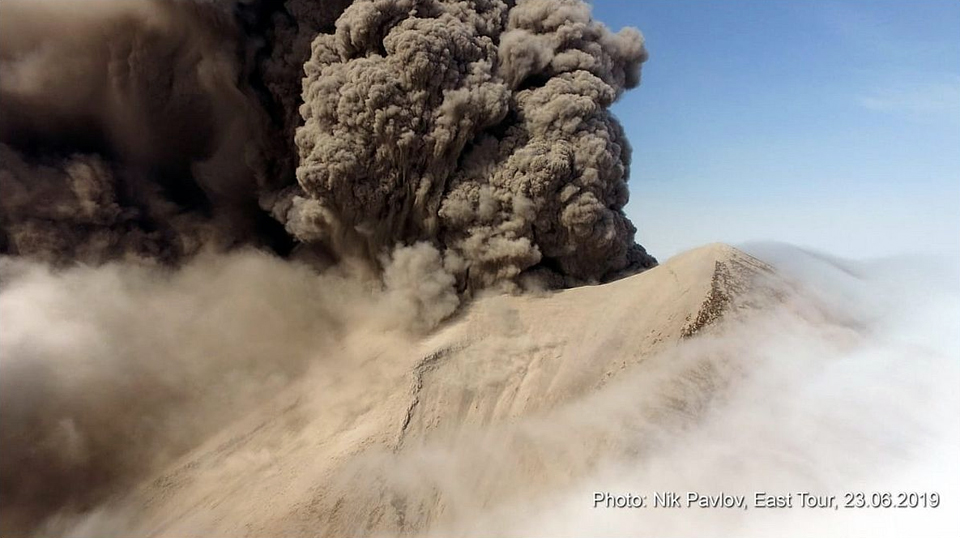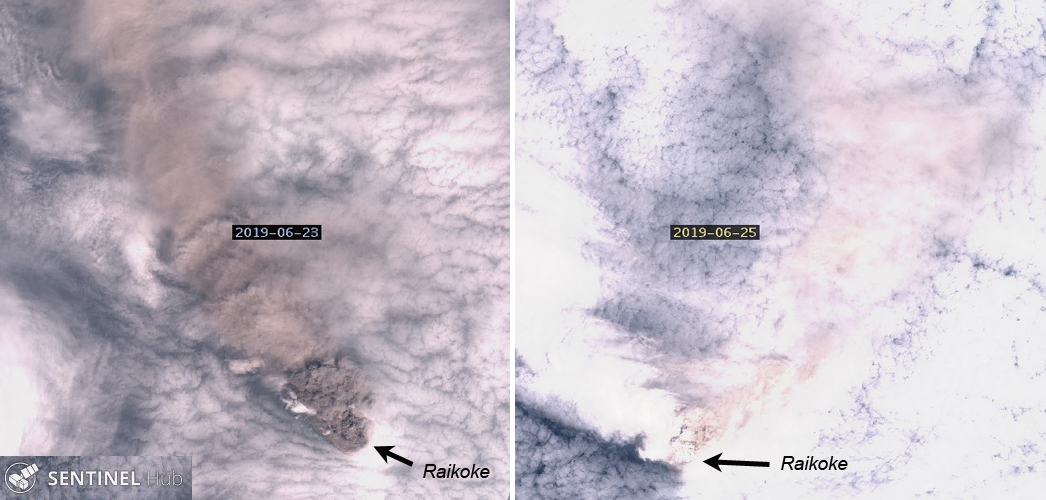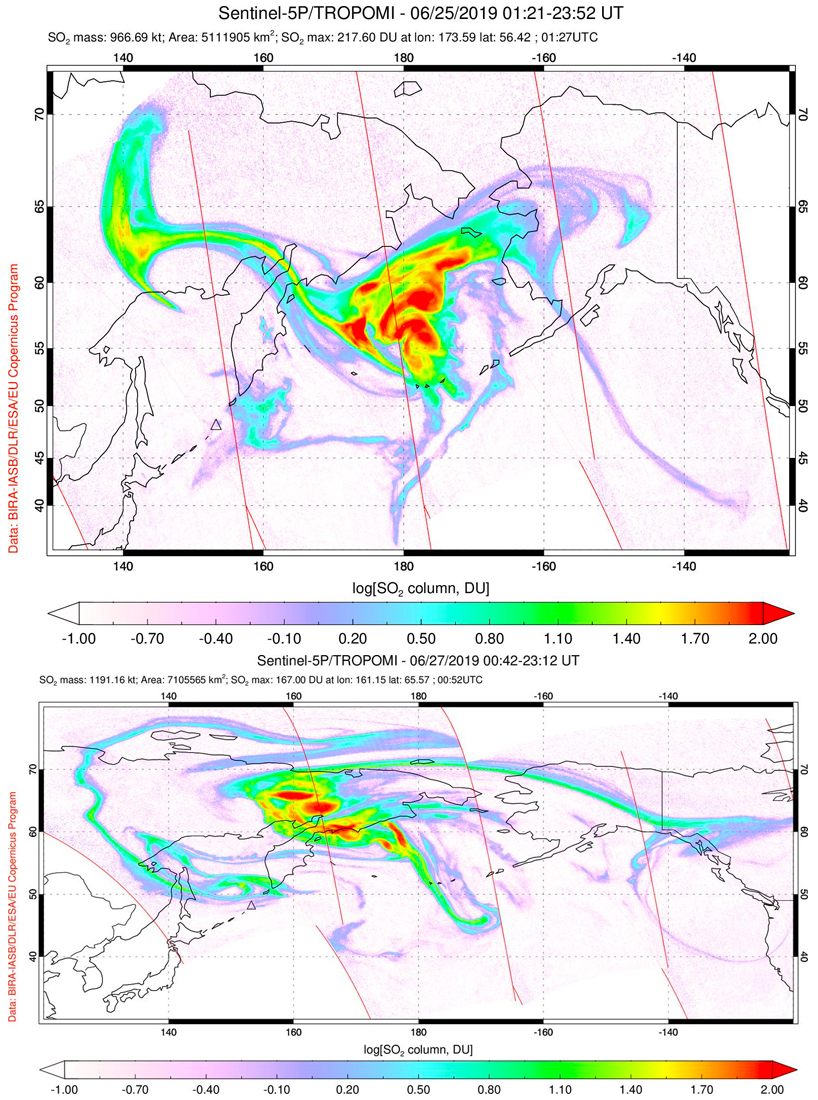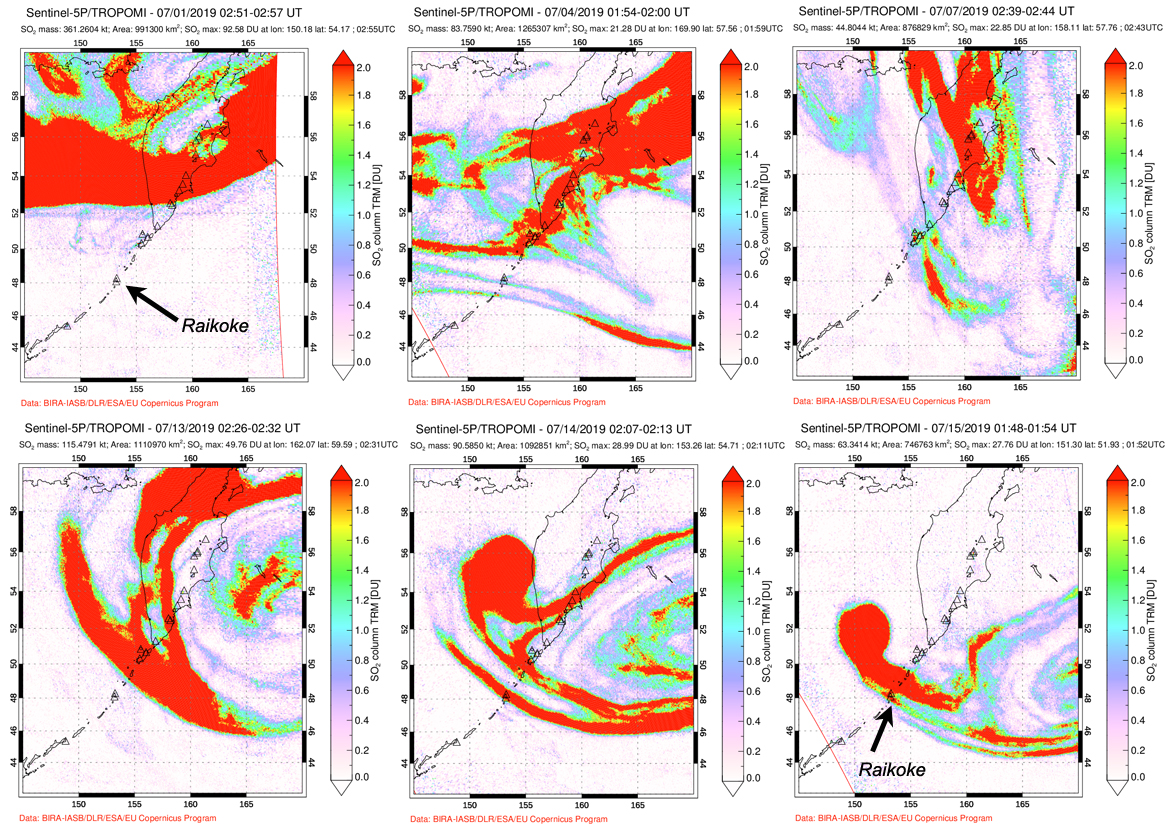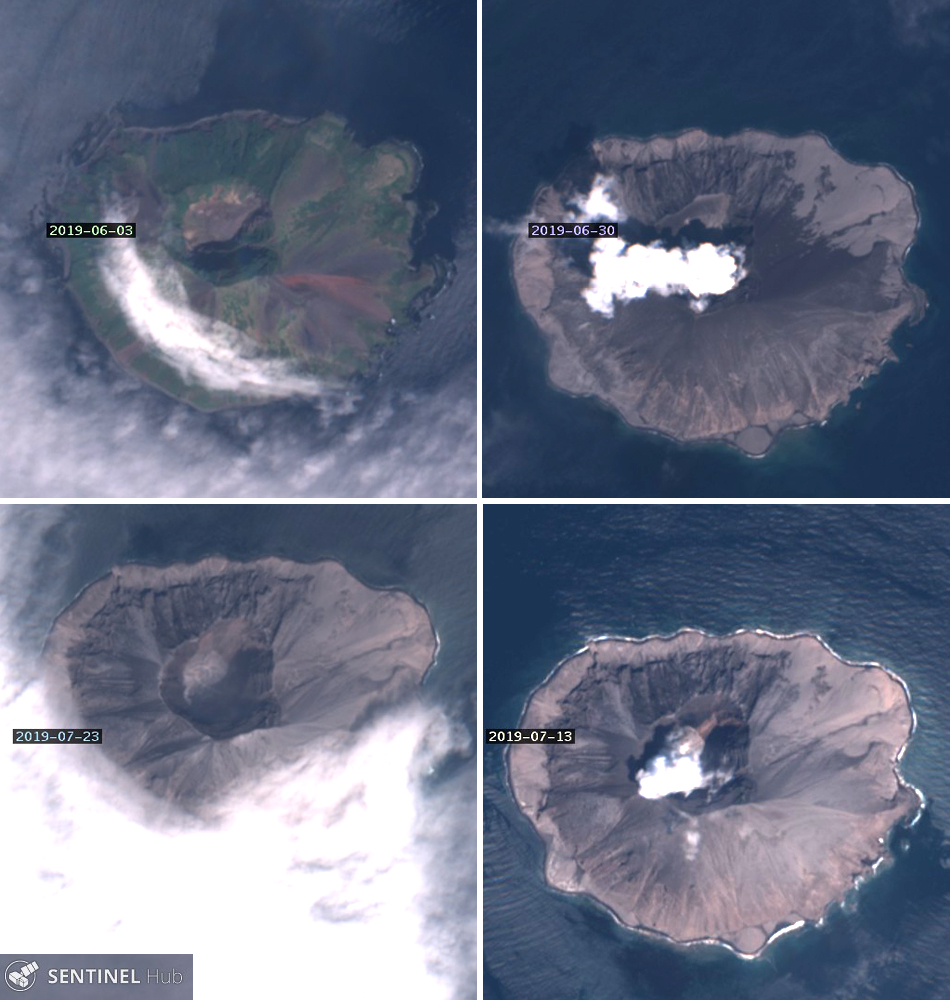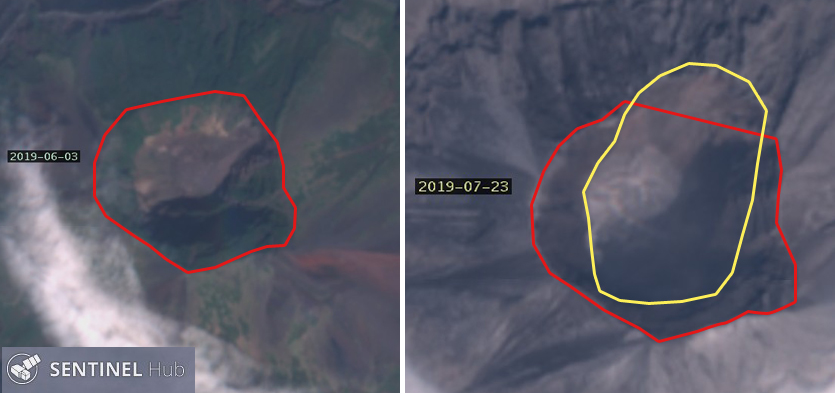Report on Raikoke (Russia) — August 2019
Bulletin of the Global Volcanism Network, vol. 44, no. 8 (August 2019)
Managing Editor: Edward Venzke.
Edited by A. Elizabeth Crafford.
Raikoke (Russia) Short-lived series of large explosions 21-23 June 2019; first recorded activity in 95 years
Please cite this report as:
Global Volcanism Program, 2019. Report on Raikoke (Russia) (Crafford, A.E., and Venzke, E., eds.). Bulletin of the Global Volcanism Network, 44:8. Smithsonian Institution. https://doi.org/10.5479/si.GVP.BGVN201908-290250
Raikoke
Russia
48.292°N, 153.25°E; summit elev. 551 m
All times are local (unless otherwise noted)
Raikoke in the central Kuril Islands lies 400 km SW of the southern tip of Russia's Kamchatcka Peninsula. Two significant eruptive events in historical times, including fatalities, have been recorded. In 1778 an eruption killed 15 people "under the hail of bombs" who were under the command of Captain Chernyi, returning from Matua to Kamchatka. This prompted the Russian military to order the first investigation of the volcanic character of the island two years later (Gorshkov, 1970). Tanakadate (1925) reported that travelers on a steamer witnessed an ash plume rising from the island on 15 February 1924, observed that the island was already covered in ash from recent activity, and noted that a dense steam plume was visible for a week rising from the summit crater. The latest eruptive event in June 2019 produced a very large ash plume that covered the island with ash and dispersed ash and gases more than 10 km high into the atmosphere. The volcano is monitored by the Sakhalin Volcanic Eruption Response Team, (SVERT) part of the Institute of Marine Geology and Geophysics, Far Eastern Branch of the Russian Academy of Sciences (IMGG FEB RAS) and the Kamchatka Volcanic Eruption Response Team (KVERT) which is part of the Institute of Volcanology and Seismology, Far Eastern Branch of the Russian Academy of Sciences (IVS FEB RAS).
A brief but intense eruption beginning on 21 June 2019 sent major ash and sulfur dioxide plumes into the stratosphere (figures 1 and 2); the plumes rapidly drifted over 1,000 km from the volcano. Strong explosions with dense ash plumes lasted for less than 48 hours, minor emissions continued for a few more days; the SO2, however, continued to circulate over far eastern Russia and the Bering Sea for more than three weeks after the initial explosion. The eruption covered the island with centimeters to meters of ash and enlarged the summit crater. By the end of July 2019 only minor intermittent steam emissions were observed in satellite imagery.
Summary of 2019 activity. A powerful eruption at Raikoke began at 1805 on 21 June 2019 (UTC). Volcano Observatory Notices for Aviation (VONA's) issued by KVERT described the large ash plume that rapidly rose to 10-13 km altitude and extended for 370 km NE within the first two hours (figure 3). After eight hours, the plume extended 605 km ENE; it had reached 1,160 km E by 13 hours after the first explosion (figure 4). The last strong explosive event, according to KVERT, producing an ash column as high as 10-11 km, occurred at 0540 UTC on 22 June. SVERT reported a series of nine explosions during the eruption. Over 440 lightning events within the ash plume were detected in the first 24 hours by weather-monitoring equipment. The Japanese Ministry of Transportation reported that almost 40 planes were diverted because of the ash plume (figure 5).
On 23 June (local time) the cruise ship Athena approached the island; expedition member Nikolai Pavlov provided an eyewitness account and took remarkable drone photographs of the end of the eruption. The ship approached the W flank of the island in the late afternoon and they were able to launch a drone and photograph the shore and the summit. They noted that the entire surface of the island was covered with a thick layer of light-colored ash up to several tens of centimeters thick (figure 6). Fresh debris up to several meters thick fanned out from the base of the slopes (figure 7). The water had a yellowish-greenish tint and was darker brown closer to the shore. Dark-brown steam explosions occurred when waves flowed over hot areas along the shoreline, now blanketed in pale ash with bands of steam and gas rising from it (figure 8). A dense brown ash plume drifted W from the crater, rising about 1.5 km above the summit (figure 9).
Early on 23 June, the large ash cloud continued to drift E and then NE at an altitude of 10-13 km. At that altitude, the leading edge of the ash cloud became entrained in a large low pressure system and began rotating from SE to NW, centered in the area of the Komandorskiye Islands, 1,200 km NE of Raikoke. By then the farthest edge of ash plume was located about 2,000 km ENE of the volcano. Meanwhile, at the summit and immediately above, the ash plume was drifting NW on 23 June (figures 9 and 10). Ashfall was reported (via Twitter) from a ship in the Pacific Ocean 40 km from Raikoke on 23 June. Weak ashfall was also reported in Paramushir, over 300 km NE the same day. KVERT reported that satellite data from 25 June indicated that a steam and gas plume, possibly with some ash, extended for 60 km NW. They also noted that the high-altitude "aerosol cloud" continued to drift to the N and W, reaching a distance of 1,700 km NW (see SO2 discussion below). By 27 June KVERT reported that the eruption had ended, but the aerosols continued to drift to the NW and E. They lowered the Aviation Alert Level to Green the following day.
Tokyo and Anchorage VAAC Reports. The Tokyo VAAC first observed the ash plume in satellite imagery at 10.4 km altitude at 1850 on 21 June 209, just under an hour after the explosion was first reported by KVERT. About four hours later they updated the altitude to 13.1 km based on satellite data and a pilot report. By the evening of 22 June the high-level ash plume was still drifting ESE at about 13 km altitude while a secondary plume at 4.6 km altitude drifted SE for a few more hours before dissipating. The direction of the high-altitude plume began to shift to the NNW by 0300 on 23 June. By 0900 it had dropped slightly to 12.2 km and was drifting NE. The Anchorage VAAC reported at 2030 that the ash plume was becoming obscured by meteorological clouds around a large and deep low-pressure system in the western Bering Sea. Ash and SO2 signals in satellite imagery remained strong over the region S and W of the Pribilof Islands as well as over the far western Bering Sea adjacent to Russia. By early on 24 June the plume drifted NNW for a few hours before rotating back again to a NE drift direction. By the afternoon of 24 June, the altitude had dropped slightly to 11.6 km as it continued to drift NNE.
The ash plume was still clearly visible in satellite imagery late on 24 June. An aircraft reported SO2 at 14.3 km altitude above the area of the ash plume. The plume then began to move in multiple directions; the northern part moved E, while the southern part moved N. The remainder was essentially stationary, circulating around a closed low-pressure zone in the western Bering Sea. The ash plume remained stationary and slowly dissipated as it circulated around the low through 25 June before beginning to push S (figure 11). By early on 26 June the main area of the ash plume was between 325 km WSW of St. Matthew Island and 500 km NNW of St. Lawrence Island, and moving slowly NW. The Anchorage VAAC could no longer detect the plume in satellite imagery shortly after midnight (UTC) on 27 June, although they noted that areas of aerosol haze and SO2 likely persisted over the western Bering Sea and far eastern Russia.
Sulfur dioxide emissions. A very large SO2 plume was released during the eruption. Preliminary total SO2 mass estimates by Simon Carn taken from both UV and IR sensors suggested around 1.4-1.5 Tg (1 Teragram = 109 Kg) that included SO2 columns within the ash plume with values as high as 1,000 Dobson Units (DU) (figure 12). As the plume drifted on 23 and 24 June, similar to the ash plume as described by the Tokyo VAAC, it moved in a circular flow pattern as a result of being entrained in a low-pressure system in the western Bering Sea (figure 13). By 25 June the NW edge of the SO2 had reached far eastern Russia, 1,700 km from the volcano (as described by KVERT), while the eastern edges reached across Alaska and the Gulf of Alaska to the S. Two days later streams of SO2 from Raikoke were present over far northern Siberia and northern Canada (figure 14). For the following three weeks high levels of SO2 persisted over far eastern Russia and the Bering Sea, demonstrating the close relationship between the prevailing weather patterns and the aerosol concentrations from the volcano (figure 15).
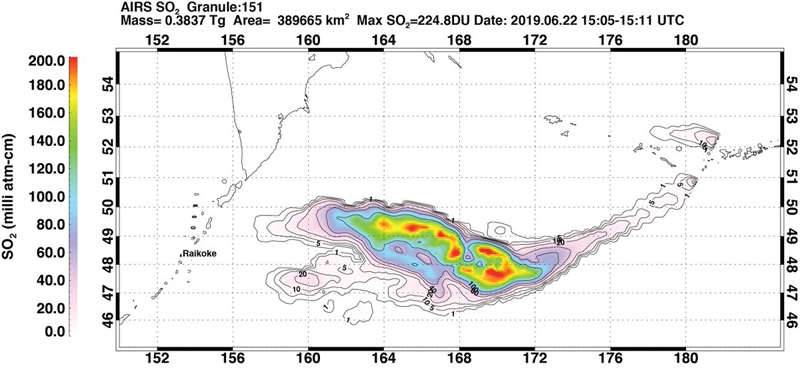 |
Figure 12. A contour map showing the mass and density of SO2 released into the atmosphere from Raikoke on 22 June 2019. Courtesy of Simon Carn. |
Changes to the island. Since no known activity had occurred at Raikoke for 95 years, the island was well vegetated on most of its slopes and the inner walls of the summit crater before the explosion (figure 16). The first clear satellite image after the explosion, on 30 June 2019, revealed a modest steam plume rising from the summit crater, pale-colored ash surrounding the entire island, and new deposits of debris fans extending out from the NE, SW, and S flanks. Part of a newly enlarged crater was visible at the N edge of the old crater. Two weeks later only a small steam plume was present at the summit, making the outline of the enlarged crater more visible; the extensive shoreline deposits of fresh volcanic material remained. A clear view into the summit crater on 23 July revealed the size and shape of the newly enlarged summit crater (figure 17).
References: Gorshkov G S, 1970, Volcanism and the Upper Mantle; Investigations in the Kurile Island Arc, New York: Plenum Publishing Corp, 385 p.
Tanakadate H, 1925, The volcanic activity in Japan during 1914-1924, Bull Volc. v. 1, no. 3.
Geological Summary. A low truncated volcano forms the small barren Raikoke Island, which lies 16 km across the Golovnin Strait from Matua Island in the central Kuriles. The oval-shaped basaltic island is only 2 x 2.5 km wide and rises above a submarine terrace. An eruption in 1778, during which the upper third of the island was said to have been destroyed, prompted the first volcanological investigation in the Kuril Islands two years later. Incorrect reports of eruptions in 1777 and 1780 were due to misprints and errors in descriptions of the 1778 event (Gorshkov, 1970). Another powerful eruption in 1924 greatly deepened the crater and changed the outline of the island. Prior to a 2019 eruption, the steep-walled crater, highest on the SE side, was 700 m wide and 200 m deep. Lava flows mantle the eastern side of the island.
Information Contacts: Institute of Volcanology and Seismology, Far Eastern Branch, Russian Academy of Sciences (IVS FEB RAS), 9 Piip Blvd., Petropavlovsk-Kamchatsky 683006, Russia (URL: http://www.kscnet.ru/ivs/eng/); Sakhalin Volcanic Eruption Response Team (SVERT), Institute of Marine Geology and Geophysics, Far Eastern Branch, Russian Academy of Science, Nauki st., 1B, Yuzhno-Sakhalinsk, Russia, 693022 (URL: http://www.imgg.ru/en/, http://www.imgg.ru/ru/svert/reports); Kamchatka Volcanic Eruptions Response Team (KVERT), Far Eastern Branch, Russian Academy of Sciences, 9 Piip Blvd., Petropavlovsk-Kamchatsky, 683006, Russia (URL: http://www.kscnet.ru/ivs/kvert/); NASA Earth Observatory, EOS Project Science Office, NASA Goddard Space Flight Center, Goddard, Maryland, USA (URL: http://earthobservatory.nasa.gov/); Global Sulfur Dioxide Monitoring Page, Atmospheric Chemistry and Dynamics Laboratory, NASA Goddard Space Flight Center (NASA/GSFC), 8800 Greenbelt Road, Goddard, Maryland, USA (URL: https://so2.gsfc.nasa.gov/); Sentinel Hub Playground (URL: https://www.sentinel-hub.com/explore/sentinel-playground); NOAA, Cooperative Institute for Meteorological Satellite Studies (CIMSS), Space Science and Engineering Center (SSEC), University of Wisconsin-Madison, 1225 W. Dayton St. Madison, WI 53706, (URL: http://cimss.ssec.wisc.edu/); Simon Carn, Geological and Mining Engineering and Sciences, Michigan Technological University, 1400 Townsend Drive, Houghton, MI 49931, USA (URL: http://www.volcarno.com/, Twitter: @simoncarn); Scott Bachmeier, Cooperative Institute for Meteorological Satellite Studies (CIMSS), Space Science and Engineering Center (SSEC), University of Wisconsin-Madison, 1225 W. Dayton St. Madison, WI 53706; Flightradar24 (URL: https://www.flightradar24.com/51,-2/6); Volcano Discovery (URL: http://www.volcanodiscovery.com/).

